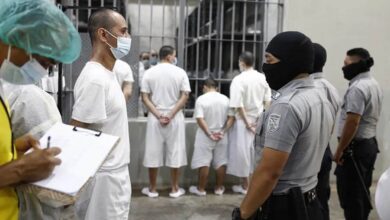Polls are valuable tools for understanding public sentiment and guiding campaign strategies. They provide a snapshot of public opinion at a given moment and can help identify trends over time. However, they are not crystal balls that predict the future with certainty.

Photo: LatinAmerican Post
The Latin American Post Staff
Escucha este artículo
Leer en español: ¿Funcionan realmente las encuestas? Desentrañando las complejidades de la previsión política moderna
Former Senator Gustavo Bolívar, the candidate for the Mayor of Bogotá from the ruling coalition Pacto Histórico, said that "polls always get it wrong," just as he claims happened in the Argentine presidential elections. He expressed hope in winning the elections on October 29.
"Polls always get it wrong, and they just got it wrong in Argentina… These companies always try to create trends to get people on the victory bus or to discourage others, but our group is very strong," the candidate said.
Bolívar referred to the presidential elections in Argentina on Sunday, which produced a surprising outcome with the ruling candidate, Sergio Massa (36.68%), coming in first and the libertarian Javier Milei (29.98%) in second place not performing as well as the polls had predicted.
In this context, a survey by the Centro Nacional de Consultoría (CNC) published on Sunday for El Tiempo and CM& indicated that former Senator Carlos Fernando Galán, from the Nuevo Liberalismo party, has 37% of the vote intention to win the mayoral elections in Bogotá, followed by Bolívar (22%) and independent candidate Juan Daniel Oviedo (17%).
In today's fast-paced, data-driven world, polls and surveys have become the lifeblood of political analysis. They're the compass that guides campaign strategies, shapes media narratives, and influences voter behavior. However, the effectiveness and accuracy of polls have come under increasing scrutiny, leading us to question: do polls work?
Polling has a rich history, dating back to the early days of the United States when straw polls gauged public opinion on various issues. Over time, polling methodologies have evolved, incorporating statistical techniques and sophisticated sampling to predict elections, referendums, and public sentiment. Yet, as the recent past has shown, these predictions can sometimes fall short of reality.
Let's dissect polling dynamics and explore whether they serve their intended purpose in today's political landscape.
The Evolution of Polling
Before we delve into the efficacy of polls, it's essential to understand their evolution. Polls are no longer conducted via landline telephones or in-person interviews alone. The digital age has brought with it a myriad of innovative polling methods. Online surveys, automated phone calls, and social media tracking now contribute to the diversity of data sources available to pollsters.
One significant development is the advent of big data. Pollsters can now access information from social media, search engine queries, and online behavior. This wealth of data allows for a more comprehensive understanding of public sentiment.
However, it's not just the methods that have evolved. The very nature of public opinion has transformed, too. In our interconnected world, information spreads like wildfire, and public opinion can swing rapidly in response to breaking news, social media trends, or charismatic politicians. This makes the job of pollsters even more challenging.
Polling's Recent Stumbles
Recent elections in various parts of the world have witnessed notable polling missteps. For instance, the 2016 U.S. presidential election saw widespread poll predictions favoring the Democratic candidate, Hillary Clinton, only for the eventual winner, Donald Trump, to defy expectations. Similarly, the Brexit referendum in the United Kingdom in 2016 left many pollsters red-faced as they failed to anticipate the "Leave" outcome.
These misfires raised pertinent questions about the reliability of polls in capturing the evolving dynamics of modern electorates. Some argue that polls tend to underestimate the influence of rural areas, where large segments of the population feel disenfranchised, often leading to unexpected electoral outcomes.
The Complexities of Polling
The primary reason behind these polling inaccuracies is the multifaceted nature of political landscapes. Polls aim to distill the sentiments of a diverse and often unpredictable electorate into numerical data. While this data can be valuable for politicians and analysts, it can only sometimes account for the intricate nuances of voter behavior.
Moreover, the response rate in modern polling has declined significantly. People are busier, more skeptical, and less inclined to answer the phone or participate in surveys. This reduction in response rates creates a potential source of bias, as those responding may need to represent the broader population accurately.
Another challenge is the phenomenon known as the "shy voter." In certain instances, individuals may feel uncomfortable expressing their true political beliefs due to societal pressure or fear of backlash. This can lead to underestimations of support for controversial candidates or positions.
Additionally, polls are snapshots capturing public sentiment at a specific moment. As mentioned earlier, public opinion can fluctuate rapidly, making it challenging to predict how it might evolve by Election Day. The influence of last-minute campaign developments or unforeseen events further complicates the accuracy of polls.
The Human Factor
One critical aspect often overlooked in polling analysis is the role of the human factor. Like any profession, pollsters can make mistakes or have biases that influence their work. In some cases, these biases can manifest in how questions are framed, the choice of sample size, or the weighting of responses.
There's also the issue of partisan polling. Political parties or interest groups commission some polls, and their agendas may influence the results. This inherent bias can distort the accuracy of polling data.
Polls: Tools, Not Crystal Balls
So, do polls work? The answer is a nuanced one. Polls are valuable tools for understanding public sentiment and guiding campaign strategies. They provide a snapshot of public opinion at a given moment and can help identify trends over time. However, they are not crystal balls that predict the future with certainty.
Also read: Colombia: This Is The Electoral Panorama In The Main Departmental Capitals
Polling should be seen as an evolving and adaptive process. Pollsters must continually refine their methods to account for the changing landscape of politics and the intricacies of voter behavior. Moreover, analysts and the public must view polls critically, considering potential biases and limitations.
In an era of rapidly shifting political dynamics and a polarized electorate, polling is more challenging than ever. The complexities of human behavior and the unpredictability of political events make it impossible to create foolproof forecasts. Nevertheless, when used with caution and a nuanced understanding of their limitations, polls remain valuable for shedding light on the often murky waters of public opinion.
In conclusion, polls may only sometimes get it right, but they serve an essential purpose in the political process. They provide insights into voters' minds, help campaigns fine-tune their strategies, and offer a point of reference for understanding the ebb and flow of public sentiment. It's not that polls are fundamentally flawed; the world they seek to measure is increasingly complex and fluid. So, while we shouldn't rely on polls as definitive predictions, we should continue to use them as valuable instruments in the ever-evolving landscape of politics.




